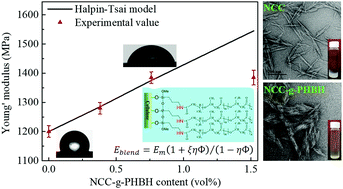Effects of modified nanocrystalline cellulose on the hydrophilicity, crystallization and mechanical behaviors of poly(3-hydroxybutyrate-co-3-hydroxyhexanoate)†
Abstract
Fine dispersion of nanocrystalline cellulose (NCC) in a bacterially synthesized poly(3-hydroxybutyrate-co-3-hydroxyhexanoate) (PHBH) matrix is challenging due to their incompatibility. To improve their compatibility, NCC was first grafted with PHBH, marked as NCC-g-PHBH, using (3-aminopropyl)triethoxysilane (APES) as a coupling agent, leading to a grafting degree of ∼25 wt%. The grafting mechanism and the mechanical and crystallization behaviors of the PHBH/NCC-g-PHBH blends, prepared via solution casting, were systematically investigated. The NCC was uniformly dispersed in the PHBH matrix after grafting with PHBH. As a consequence, the mechanical and crystallization properties of the PHBH were greatly improved in the presence of the NCC-g-PHBH. With the addition of 1.0 wt% NCC-g-PHBH, the Young's modulus of the PHBH/NCC-g-PHBH blend was increased by 15%, which is further evaluated by the Halpin–Tsai model, while the surface contact angles decreased by 30°. Furthermore, the presence of NCC-g-PHBH copolymers greatly increased the nuclei density and decreased the spherulite size of PHBH without changing the crystal structures. Therefore, this work provided a novel route to prepare fully biodegradable and bio-based PHBH nanocomposites, which may broaden the application range of PHBH.



 Please wait while we load your content...
Please wait while we load your content...